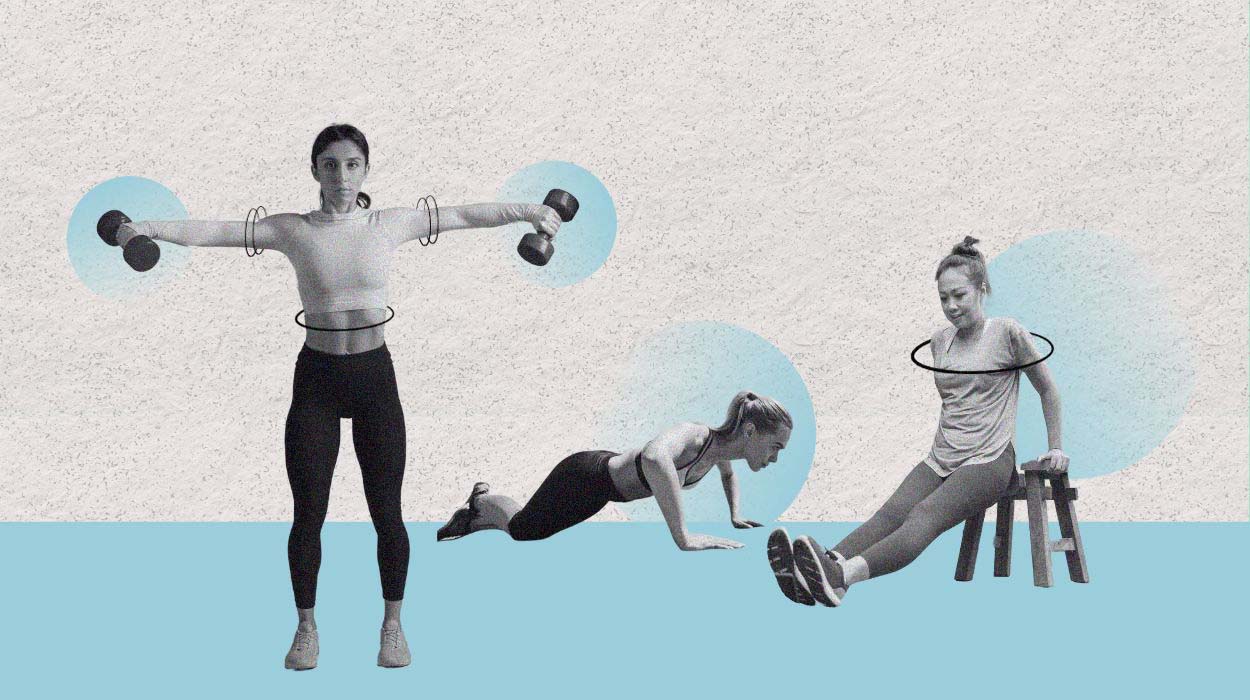
Starting a beginner arm workout is challenging. You want tone, definition, and a weight loss solution. Keeping yourself fit is vital, and that includes your arms.
Some of these exercises target fat, while others help you gain strength and muscle.[1] Don’t forget to consult your doctor or a licensed fitness coach before commencing a new arm workout routine or incorporating fat burners into your exercise. Consider these easy arm workouts to get started and begin seeing results in no time.
10 Best Arm Strengthening Exercises For Beginners
Here are ten upper body exercises to strengthen your arms:
Best Beginner Arm Workout To Start Now
Explore the ‘Beginner Arm Workout’ – an essential foundation for those taking their first steps in the realm of arm strength training. This well-structured routine is your gateway to building foundational arm strength with a focus on simplicity and effectiveness.
Kneeling Push-Ups
Kneeling Push-Ups, like any basic arm workout, start you off slow, which helps avoid injuries when working out new body parts. These upper-body exercises give you the perfect intro to standard push-ups and other difficult arm or shoulder workouts.
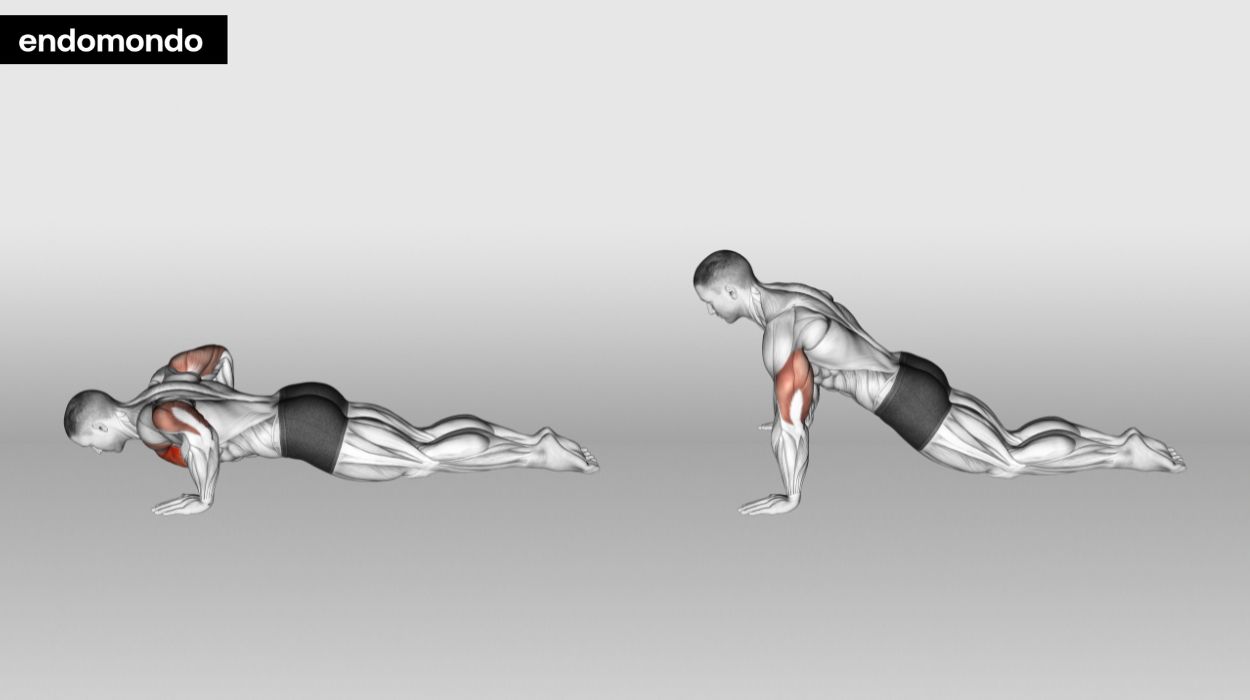
How to do:
- Kneel on the floor or exercise mat.
- Extend your right arm and left arm.
- Put your hands shoulder-width apart on the floor or mat in front of you. Tighten your abs.
- Keeping your body in a straight line from your head to your knees, bend your arms and lower your torso until your chest grazes the floor.
- Straighten your arms while slowly pushing your torso back up.
Tips:
- Keep your spine straight.
- Activate your shoulder muscles while lowering to the floor.
- Tighten your abs and butt to strengthen your core.
- Push your weight into your fingers and whole hand rather than just your wrist.
Optimal Sets And Reps: 3 sets of 8-12 reps.
Assisted Pull-Ups
An Assisted Pull-Up is a great beginner arm workout for a female. Consider using exercise bands while doing this exercise at home. Make sure they are the correct size and made of materials that feel good to you. The tightness of the band is color-coded.
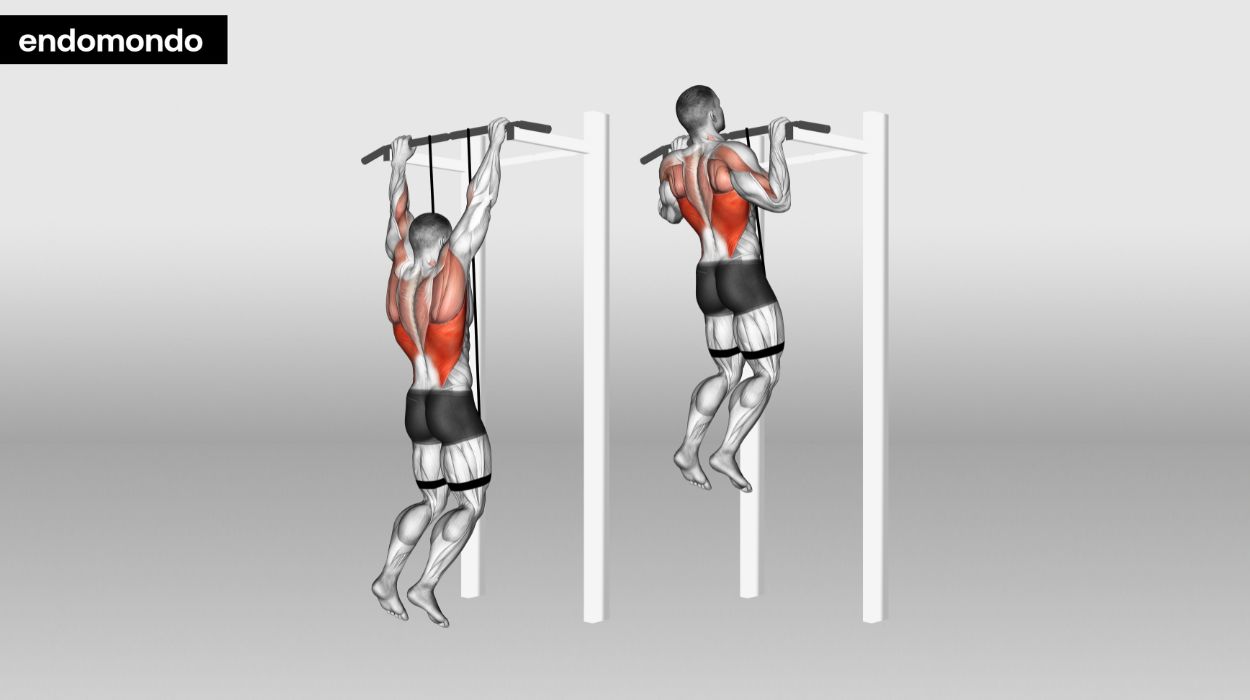
How to do:
- Secure the bands over the top of a pull-up bar. Ensure the band doesn’t reach the ground while standing on it. Adjust the length of the band if needed.
- Hang off the bar with your feet or knees in the band for support and with your arms extended fully.
- Use an overhand grip, and grip the bar with your hands a little wider than shoulder-width apart.
- Bend your elbows and pull your chin up to the bar.
- Pause here for a moment before slowly lowering back down.
- Breathe deeply for one or two seconds before repeating.
Tips:
- Engage your core muscles throughout the exercise to maintain stability and prevent swinging.
- Choose the appropriate level of assistance that allows you to complete the prescribed sets and reps with the proper form.
- Gradually decrease the assistance (e.g., lighter resistance band or reduced counterweight) as you progress to build strength for unassisted pull-ups.
Optimal Sets And Reps: 3 sets of 6-10 reps.
Bench Dips
The Bench Dips are fairly simple beginner upper body workouts for males and females. Easily locate benches in weight rooms, parks, or living rooms. Pay attention to proper form to increase shoulder joint function and avoid injury.
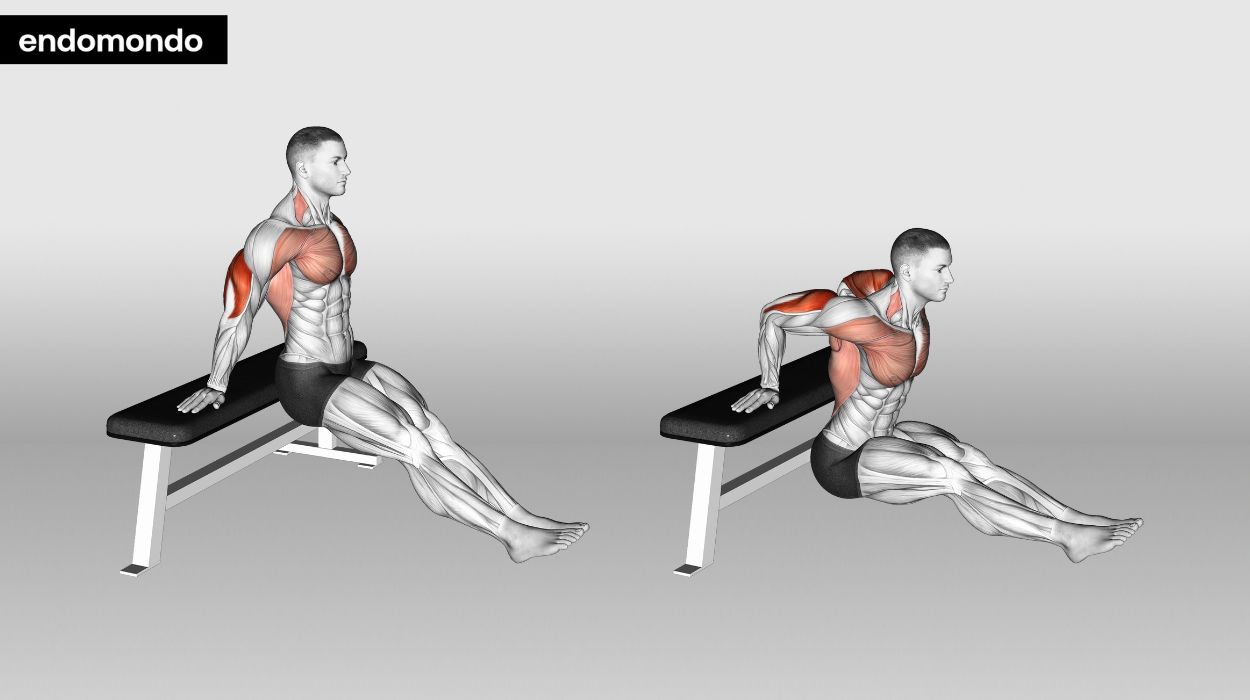
How to do:
- Sit on the edge of a flat bench.
- Place your hands on the bench so that your hands face out and away from you. Keep your feet flat on the floor and your knees slightly bent at a 90-degree angle. You can fully extend your legs if you wish to make this exercise harder.
- Push up off the bench, squeezing your shoulder blades to create tension.
- Bend your elbows to lower your body toward the floor. Don’t let your elbows exceed your shoulder height.
- Extend your elbows and squeeze your triceps to raise back up.
Tips:
- Ensure your hands are positioned shoulder-width apart on the bench for optimal stability and comfort.
- Keep your back close to the bench and your body upright to maintain proper form.
- Gradually increase the difficulty by placing your feet on an elevated surface or adding weight to your lap as you progress.
Optimal Sets And Reps: 3 sets of 6-12 reps.
Lateral Raises
This strength training and isolation exercise works the shoulders and upper back. Lateral Raises are a beginner upper body workout females will love.
This movement involves lifting weights[2] away from your body and out to the side. Use light weights to build strength and size while preventing injury. Arm workouts with weights can also be a core exercise that will create stability throughout the upper body.
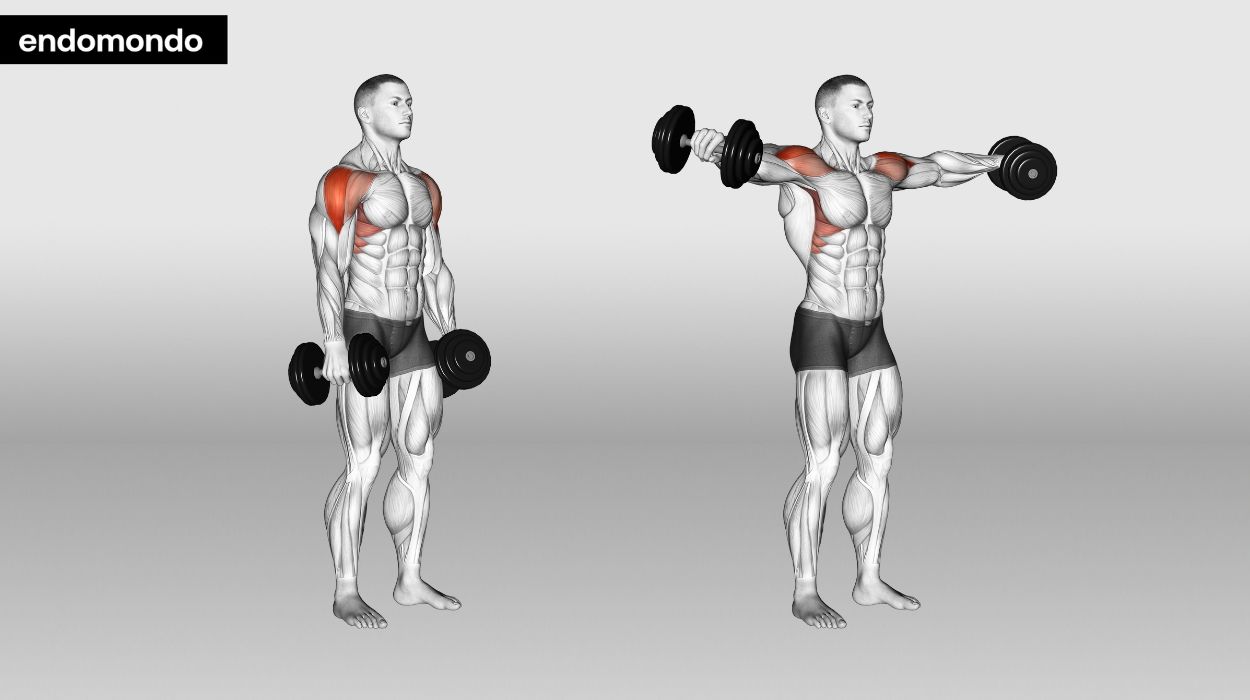
How to do:
- Stand with your feet shoulder-width apart. Hold a dumbbell in each hand by your sides with your palms facing in.
- Engage your core and squeeze your glutes as you raise your arms out to the sides.
- Stop when your arms get to be parallel to the floor.
- Pause before slowly returning to the start position.
Tips:
- Use controlled movements and avoid using momentum to lift the weights to shoulder height.
- Keep a slight bend in your elbows and maintain a soft grip on the dumbbells to reduce strain on your joints.
- Start with a manageable weight and focus on the mind-muscle connection for optimal shoulder engagement.
Optimal Sets And Reps: 2 sets of 8-12 reps
Dumbbell Bicep Curls
This exercise is a great way to target the biceps and forearms, especially when done slowly and in a controlled manner.
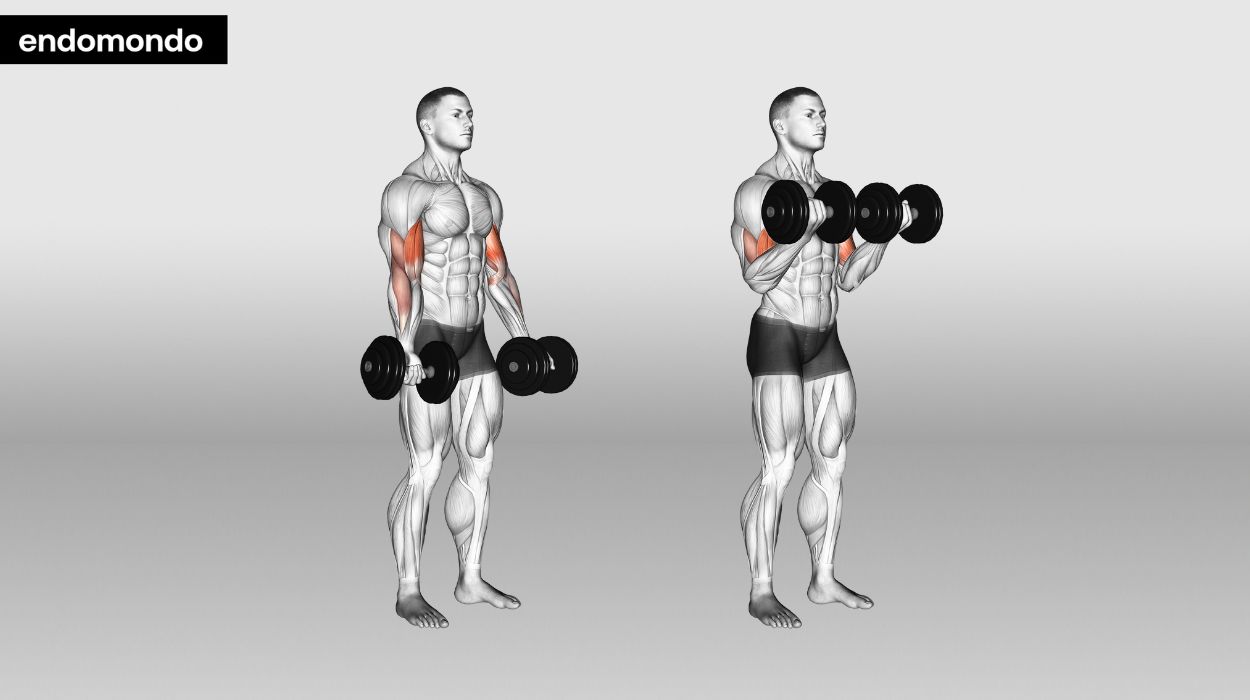
How to do:
- Hold a pair of dumbbells and stand straight up with the dumbbells down by your sides and your palms facing forward.
- With elbows bent, keep tension on the biceps. Slowly curl the dumbbells up toward your shoulders.
- Squeeze your biceps and slowly lower the dumbbells back down to the starting position.
Tips:
- Ensure a full range of motion by fully extending your arms at the bottom of each repetition and squeezing your biceps at the top.
- Avoid swinging your body or using your back to lift the weights, focusing solely on your biceps.
- Keep a steady tempo, both during the lifting and lowering phases, to maintain tension on the biceps throughout the exercise.
Optimal Sets And Reps: 3 sets of 10-15 reps.
Overhead Press
This challenging exercise should be included in most upper-body routines. Follow instructions to do this safely and effectively.
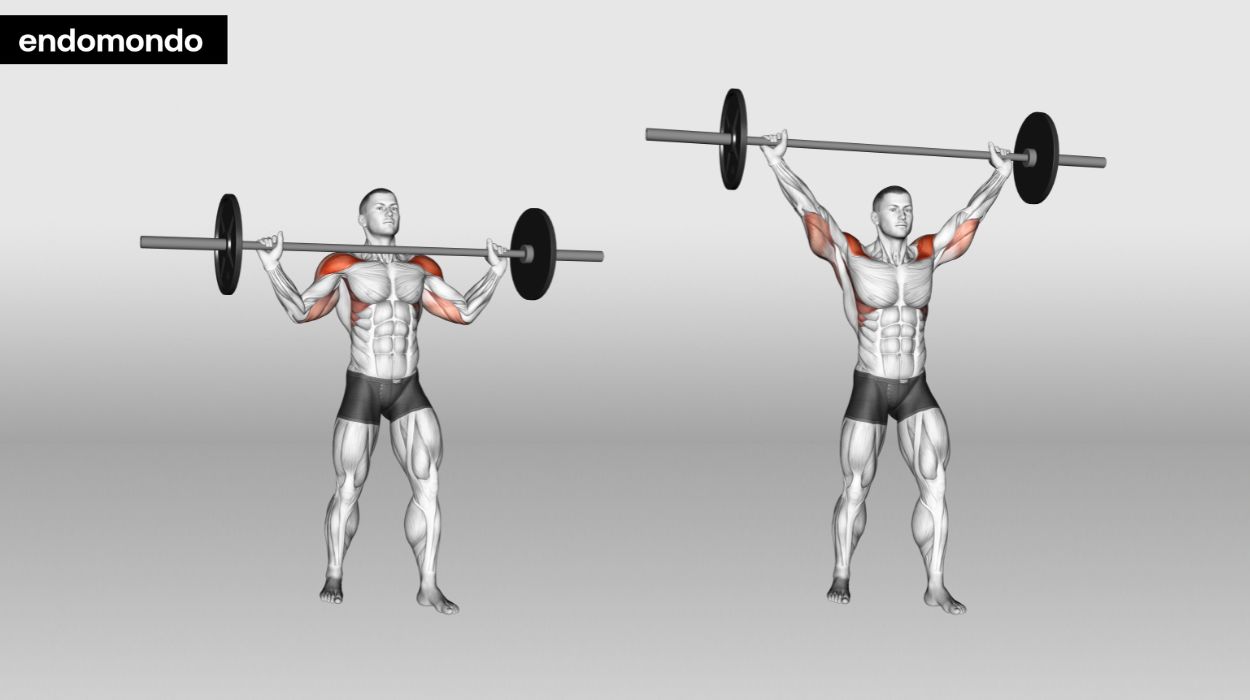
How to do:
- Stand with your body straight, holding a barbell across your chest with your palms facing forward and slightly wider than shoulder width.
- Press the bar up until your arms are fully straightened and your biceps are by your ears.
- Bend your elbows to slowly lower the barbell back down.
Tips:
- Keep your wrists straight and stacked under the barbell to prevent excessive strain on your wrists.
- Avoid locking out your elbows completely at the top of the movement to maintain tension on your shoulder muscles.
- Ensure your feet are hip-width apart and firmly planted for a stable base to press from.
Optimal Sets And Reps: 3 sets of 8-10 reps
Tricep Kickbacks
The Tricep Kickbacks exercise builds upper body strength, tones your triceps muscle, and stabilizes your shoulder joint. This is important for daily activities and sports like tennis, volleyball, and basketball.
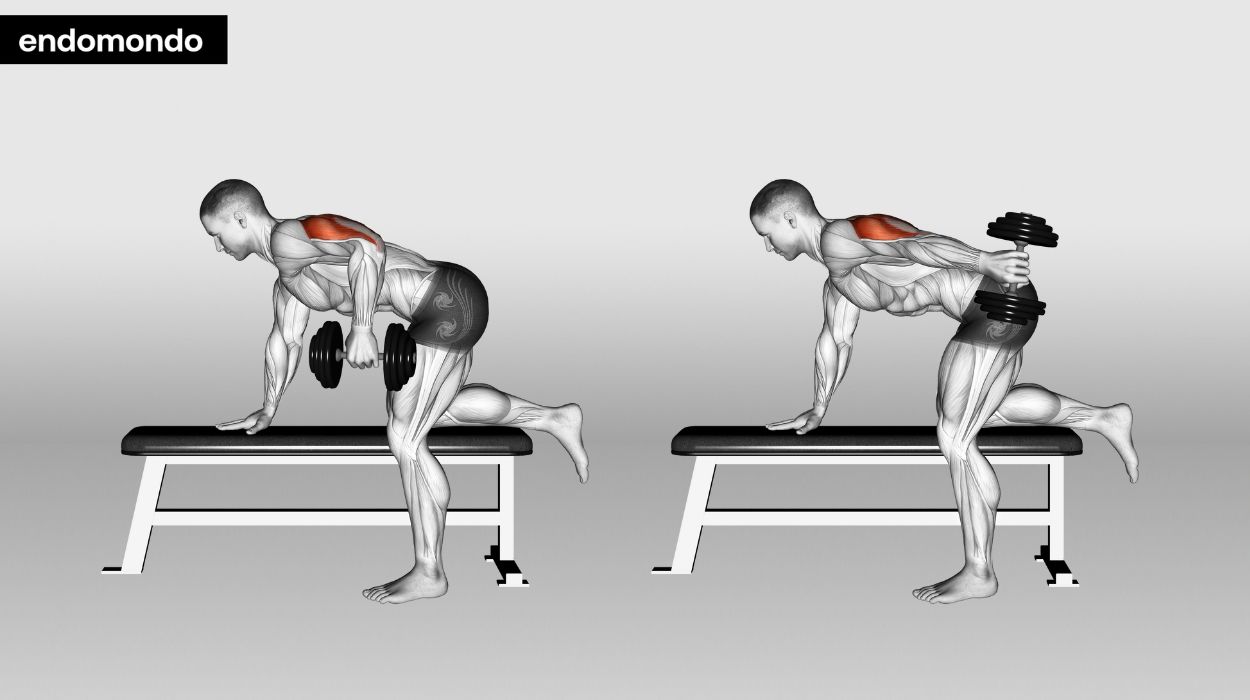
How to do:
- Hold a dumbbell in each hand and keep your palms facing each other. Keep your knees slightly bent, engage your core, and keep a straight spine as you lean forward at the waist. Bring your torso almost parallel to the floor.
- Tuck your upper arms in close to your body. Breathe out and engage your triceps by straightening your elbows so your arms are parallel to the floor. Move only your forearms during this movement.
- Breathe in while returning the weights to the starting position.
Tips:
- Maintain a neutral spine and engage your core to prevent lower back strain during the exercise.
- Use a controlled tempo, both during the extension and return phases, to maximize tricep engagement.
- Experiment with different grips and handle variations to target various parts of the triceps.
Optimal Sets And Reps: 3 sets of 8-12 reps.
Dumbbell Chest Press
Dumbbell Chest Presses are similar to the barbell bench press in the movement. You can lift in a better position with a better range of motion when you do this dumbbell exercise.
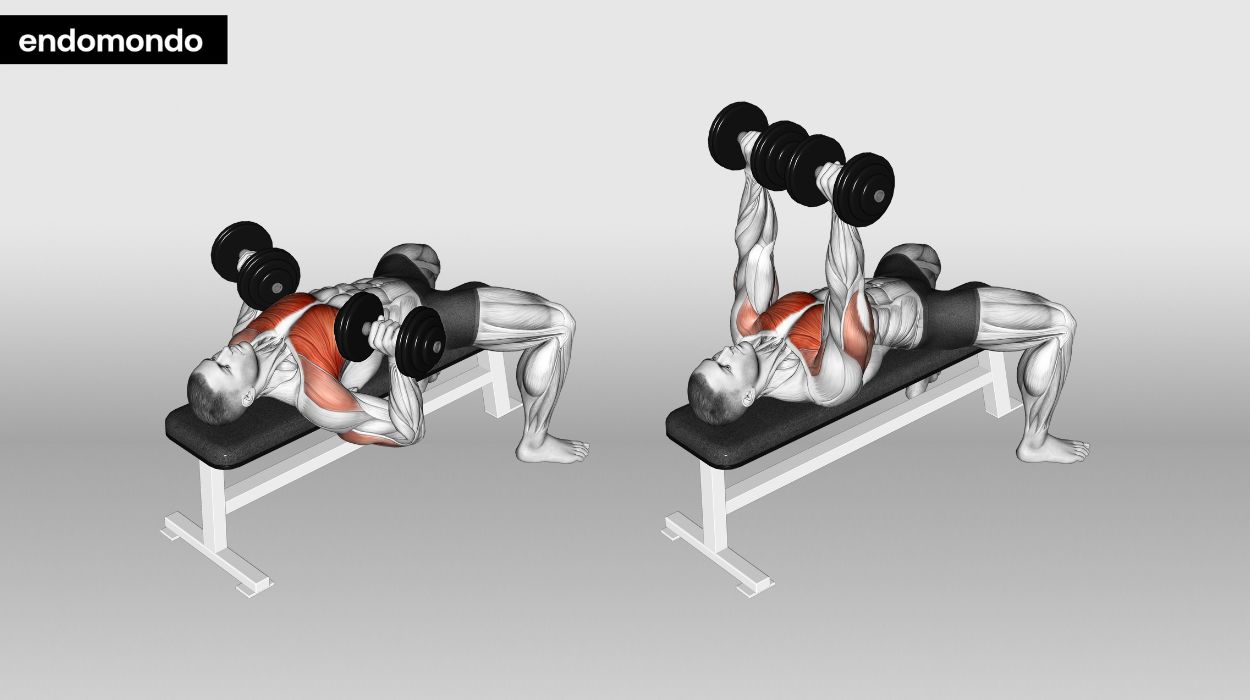
How to do:
- Lie on a flat bench with your feet flat on the floor. Hold a dumbbell in each hand and extend your arms fully so the dumbbells are above your chest.
- Breathe in as you bend your elbows and slowly lower the dumbbells down to your chest.
- Pause for a moment before breathing out and pushing the dumbbells back up to the starting position.
Tips:
- Engage your core throughout the exercise to stabilize your body and protect your spine.
- Lower the dumbbells under control, and press them explosively to maximize chest muscle engagement.
- Maintain a balanced grip and equal distribution of effort between both arms to avoid muscle imbalances.
Optimal Sets And Reps: 3 sets of 10-12 reps.
Barbell Bicep Curls
This is a great arm workout for beginners, particularly males. At first, keep the weight low while learning the right technique, and slowly increase the number of reps before increasing the weight.
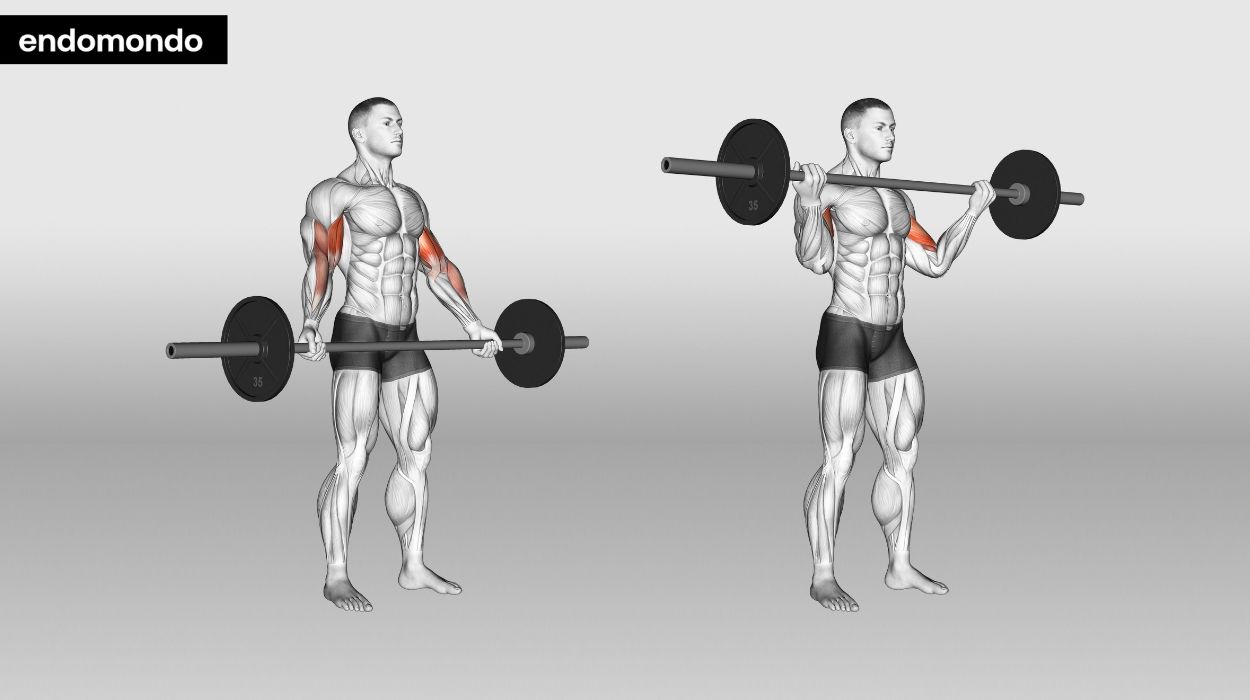
How to do:
- Stand up straight, with your feet hip-width apart. Hold the barbell in an underhand grip.
- Curl the barbell towards your chest while engaging your core and keeping your chest up and shoulders back. Feel your bicep muscle contract and hold it for a moment.
- Lower the bar slowly back to the starting position.
Tips:
- Use a full range of motion, allowing your arms to fully extend at the bottom and curl the barbell to shoulder level at the top.
- Avoid using momentum by lifting the weight with a controlled tempo.
- Maintain a strong grip on the barbell to prevent it from slipping during the exercise.
Optimal Sets And Reps: 4 sets of 10-15 reps.
Front Raises
Incorporating Front Raises, especially for beginner arm workouts for females in a gym, is a great way to work your lateral shoulder and posterior delts. This is essential for a well-developed upper body.
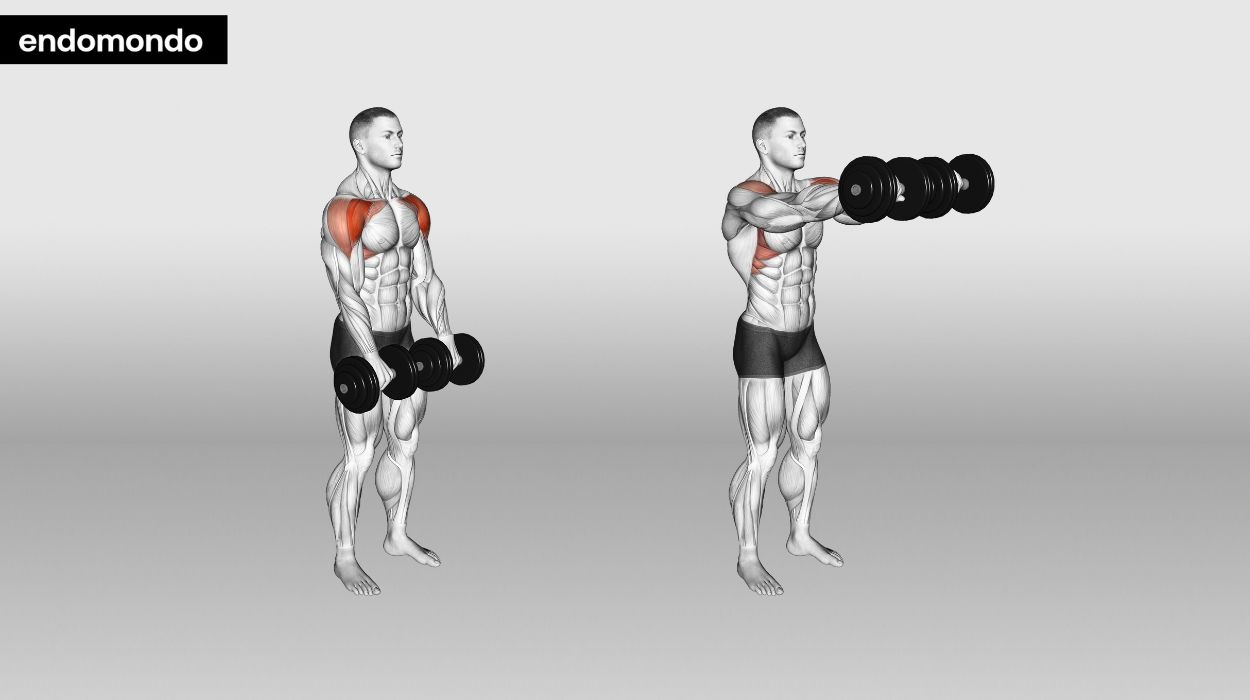
How to do:
- Stand up straight while holding a dumbbell in each hand. Have your palms facing you as your hands rest on the front of your thighs.
- Brace your core as you lift your straightened arms up until they are parallel to the floor.
- Pause here with arms extended for a moment before slowly lowering the dumbbells back down.
Tips:
- Maintain a slight bend in your elbows to prevent locking them out at the top of the movement.
- Lift the weights with control, avoiding rapid or jerky movements to target the front deltoids effectively.
- Use a weight that allows you to perform the exercise with proper form and control.
Optimal Sets And Reps: 2 sets of 8-12 reps
How To Prepare Before You Workout?
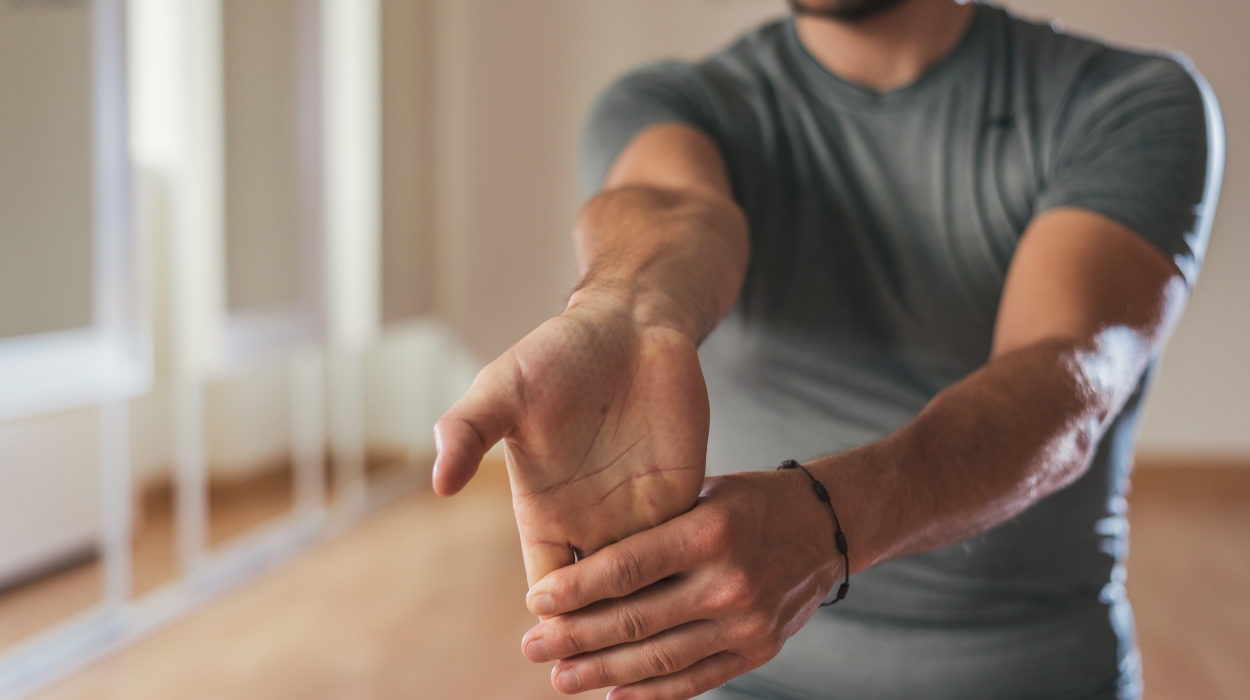
Always warm up with active range-of-motion exercises before your workout. Stretch and activate your arm muscles and get your joints ready to go. You can also engage in other five to ten-minute movements, like running, cycling, or a brisk walk.
Arm Workouts For Beginners: Things To Consider
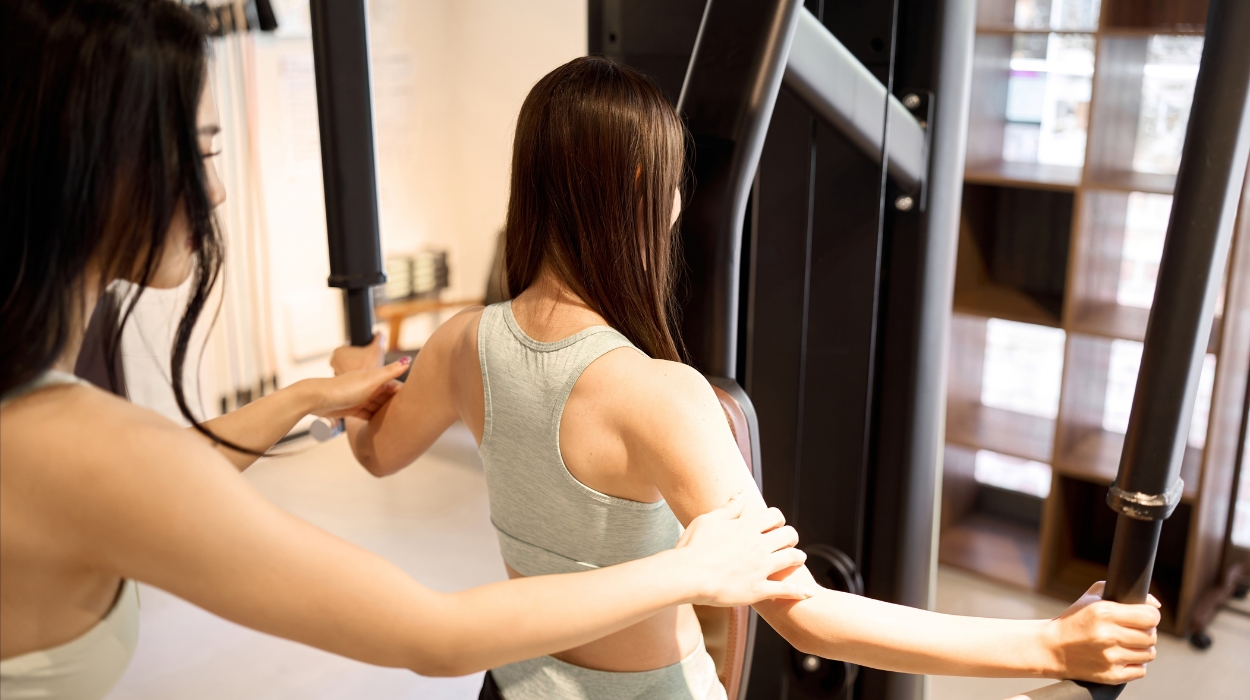
Training larger muscles like the chest, shoulders, upper arm, and back is important for overall function and injury prevention.
For example, you need strong triceps when pressing, strong biceps while rowing or performing pulldowns, and so on. You can always focus on your triceps while training your chest area as well as your biceps on days you’re focused on back training.
This ensures you get a full-body workout each week.
Conclusion
If you have the time and a proper routine, throw arm exercises into the mix. Dumbbell and kettlebell workouts can also be a part of your regular workouts. Don’t forget the importance of a healthy diet with supplements, vitamins, and nutrients for weight loss and overall health.
Those looking to build bigger biceps, triceps, and shoulders will enjoy the results of a consistent routine.
Frequently Asked Questions
Kneeling and full-body pushups are a few of the most effective arm workouts for beginners.
Yes, a beginner should start training arms one to two times per week. If your goal is to gain muscle mass, a twice-weekly workout is vital.
No, you should train arms between one and three days per week. Rest in between workouts is vital.
How often you train depends on your goals and time allowance. Aim for one to three days per week.
Resources
- Ebru Calik-Kutukcu, Hulya Arikan, Saglam, M., Naciye Vardar-Yagli, Çiğdem Öksüz, Deniz Inal-Ince, Sema Savci, Tülin Düger and Lutfi Coplu (2015). Arm strength training improves activities of daily living and occupational performance in patients with COPD. [online] 11(6), pp.820–832. doi:https://doi.org/10.1111/crj.12422.
- Schwanbeck, S., Cornish, S.M., Barss, T.S. and Chilibeck, P.D. (2020). Effects of Training With Free Weights Versus Machines on Muscle Mass, Strength, Free Testosterone, and Free Cortisol Levels. [online] 34(7), pp.1851–1859. doi:https://doi.org/10.1519/jsc.0000000000003349.




